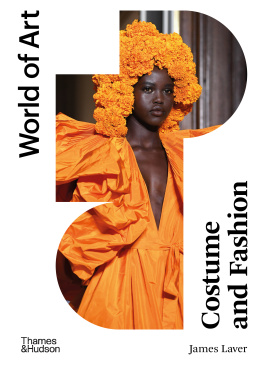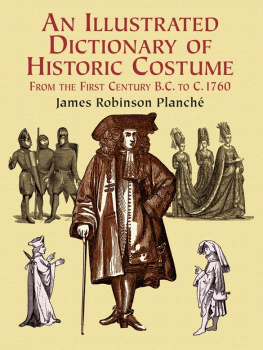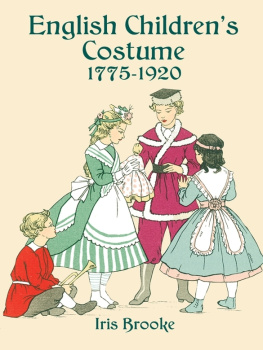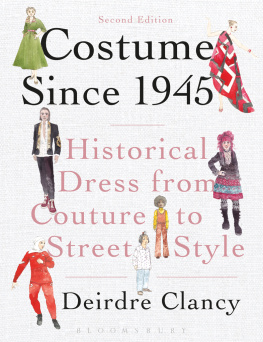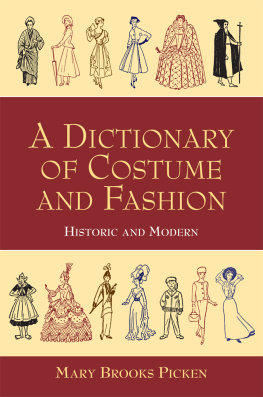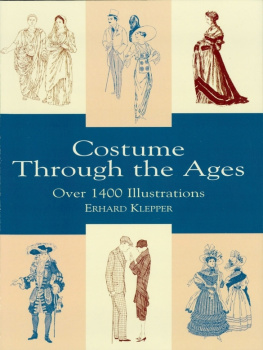James Laver - Costume and Fashion
Here you can read online James Laver - Costume and Fashion full text of the book (entire story) in english for free. Download pdf and epub, get meaning, cover and reviews about this ebook. year: 2020, publisher: Thames & Hudson, genre: Non-fiction. Description of the work, (preface) as well as reviews are available. Best literature library LitArk.com created for fans of good reading and offers a wide selection of genres:
Romance novel
Science fiction
Adventure
Detective
Science
History
Home and family
Prose
Art
Politics
Computer
Non-fiction
Religion
Business
Children
Humor
Choose a favorite category and find really read worthwhile books. Enjoy immersion in the world of imagination, feel the emotions of the characters or learn something new for yourself, make an fascinating discovery.
- Book:Costume and Fashion
- Author:
- Publisher:Thames & Hudson
- Genre:
- Year:2020
- Rating:4 / 5
- Favourites:Add to favourites
- Your mark:
- 80
- 1
- 2
- 3
- 4
- 5
Costume and Fashion: summary, description and annotation
We offer to read an annotation, description, summary or preface (depends on what the author of the book "Costume and Fashion" wrote himself). If you haven't found the necessary information about the book — write in the comments, we will try to find it.
Costume and Fashion — read online for free the complete book (whole text) full work
Below is the text of the book, divided by pages. System saving the place of the last page read, allows you to conveniently read the book "Costume and Fashion" online for free, without having to search again every time where you left off. Put a bookmark, and you can go to the page where you finished reading at any time.
Font size:
Interval:
Bookmark:



Evening dress by Jeanne Paquin, 1913.

About the Authors
James Laver, the twentieth centurys leading authority in Britain on the history of costume and fashion, was Keeper of the Department of Prints and Drawings and of Paintings at the Victoria and Albert Museum, London, from 1938 until 1959. Among his many publications were Taste and Fashion; Fashions and Fashion Plates; British Military Uniforms; Drama: Its Costume and Decor; Costume; Womens Dress in the Jazz Age; and Dandies.
Professor Amy de la Haye is Rootstein Hopkins Chair of Dress History & Curatorship at London College of Fashion. She was formerly Curator of Twentieth-Century Dress at the Victoria and Albert Museum, London. Her many publications include Chanel: Couture & Industry and, as co-author, Fashion Since 1900 (published by Thames & Hudson); Exhibiting Fashion: Before and After 1971; and Gluck: Art and Identity.
Andrew Tucker is a fashion journalist and author of The London Fashion Book; Dries Van Noten; and Fashion: A Crash Course.
Amy de la Haye
A Concise History of Costume by James Laver (18991975) was published in 1969. By situating fashion within multiple socio-cultural contexts, Lavers manuscript did much to establish fashion history as a respected academic discipline. Today, we take this for granted, but in 1969 this was not the case. Put simply, art history had academic gravitas, but fashion history did not. For Thames & Hudson to commission Laver to write a book for their prestigious and scholarly World of Art series was thus foresighted and bold. Lavers book has sold continuously for fifty years and it remains a core text for all those who study fashion history. Andrew Tucker and I have, since the first printing of the book, written chapters to bring the story up to date, and minor modifications have been made to the original manuscript in the course of updating this edition. But it remains, inevitably, a product of its time, and therefore worth situating in its own historical context.
James Laver was a trained art historian, poet, short story writer and man of multifarious interests, including the theatre. His first published work was The Young Man Dances, and Other Poems (John Castle, 1920). In 1922 Laver was appointed Assistant Keeper in the Department of Engraving, Illustration and Design at the Victoria and Albert Museum (V&A), London. Laver was charismatic and sociable, and enjoyed a high media profile. In 1937 he appeared on BBC Televisions first fashion programme, Clothes Line. His first fashion book, Taste & Fashion: From the French Revolution to the Present Day, was published by George G. Harrap the same year. In 1938 Laver was was promoted to Keeper (head of the department) at the V&A, and remained in this role until he retired in 1959. Laver was a prodigious writer, putting his name to over fifty publications, twenty-seven of which related to fashion in mens, womens and childrens dress, uniform and fashion designs on paper.
Laver was not especially interested in the material garment. His primary interest lay in the possibilities of dating works on paper by dating the styles of the fashions depicted within. In his career memoir, Museum Piece, or, The Education of an Iconographer (Andr Deutsch, 1963), he reflected that It was my own fault. I found somewhat to my distress, that my writings, especially Taste and Fashion, which came out just before the War, had established me as something of an Authority on costume. Yet my interest had never been in the dresses themselves. My study of fashion had, originally, a purely technical and utilitarian purpose, I wanted to date pictures (p. 239). This explains why so many of the images he chose for this book are paintings and illustrations.
Costume and Fashion: A Concise History, now in its sixth edition, is Lavers best-known fashion publication. For the first time minor revisions have been made to the original manuscript, and a number of the original illustrations have been updated to make the most of the new ease of colour printing. Historically, and certainly until the 1980s, the term costume was widely used in relation to fashion history and to describe the mens, womens, childrens and fancy dress housed in museum collections. More recently, the terms fashion, to describe trend-led apparel, and dress, to describe other worn items, have become standard. To ensure this book, which does focus upon fashion and dress, attracts the modern reader the title now addresses this. In places, concessions to modern sensibilities have been made: the term Eskimo has been changed to Inuit and Indian American to Native American, except where quoted. Other changes include the rephrasing of a slave in an Oriental harem to as if they belonged to an Oriental harem, not least because not all women in harems were slaves and, indeed, many exerted considerable political influence. But there remain certain anachronisms; to twenty-first-century eyes, Lavers references to the Seduction Principle (pp. 48 and 88) and the feminine Shifting Erogenous Zone (p. 231), along with his premise that the 1850s crinoline symbolized female fertility, as an expansion of the apparent size of the hips always seems to do (p. 177), are historically inaccurate and sexist. I have argued that they should be retained, however, as they are integral to Lavers approach and typical of the time in which he was writing. The reader should also be aware that Laver researched and wrote this book pre-internet access: he occasionally directs the reader to the library to obtain information that might now be available online.
In 1994, when I was working as Curator of Twentieth-Century Dress at the V&A, Thames & Hudson invited me to write a chapter to update Costume & Fashion: A Concise History, which at that time concluded in 1939. I regarded this as an honour and aimed to write a text that would continue quite seamlessly from Lavers text, while steering clear of his somewhat dubious fashion notions! I was aware that Laver was one of the first fashion historians to actively address menswear and thus, although my main interest was womens wear, I followed his lead. In the next edition respected fashion journalist Andrew Tucker, now my colleague at London College of Fashion, extended the chronology to 2002, and I wrote a further chapter that was published in 2012. This edition includes an additional chapter that in a departure from those published in previous editions privileges major political shifts within the fashion industries over the evolution of style. At the time of writing, this feels appropriate. But, history judges us all. We must remember that when Laver wrote this book, fifty years ago, the world was a very different place and his words and attitudes were not considered untoward.
James Laver dedicated his book to his great friend Doris Langley Moore (190289), writer, collector and curator, who was instrumental in establishing fashion within the context of the museum. Their joint endeavours and challenges have certainly smoothed the path of my own career and that of many of my colleagues. In turn, I would like to acknowledge Mairi Mackenzie and Jeffrey Horsley, with whom I consulted on the penultimate chapter. While writing the latest chapter I received valuable advice from Tayler Prince Fraser, Navaz Batliwalla and my son Felix Reitze de la Haye. Finally, I would like to recognize the important contribution made by my research assistant, Jihane Dyer.
Next pageFont size:
Interval:
Bookmark:
Similar books «Costume and Fashion»
Look at similar books to Costume and Fashion. We have selected literature similar in name and meaning in the hope of providing readers with more options to find new, interesting, not yet read works.
Discussion, reviews of the book Costume and Fashion and just readers' own opinions. Leave your comments, write what you think about the work, its meaning or the main characters. Specify what exactly you liked and what you didn't like, and why you think so.

